#Rijksmuseum van Oudheden Leiden
Explore tagged Tumblr posts
Photo

Detail of the bottom of the inner coffin of Gaoetsesjni, aka Gautsoshen, at the Rijksmuseum van Oudheden in Leiden. It dates to the Third Intermediate Period. I’m intrigued by the way the vulture’s long neck joins the body.
[A naked male figure, painted orange, holds up a snake across his shoulders. He has the head of a vulture. A second snake coils upwards beside his body, turning where it reaches his left elbow. Above and below the figure is the hieroglyph for sky painted black and filled with white stars.]
75 notes
·
View notes
Text




Bronstijd (Bronze Age) - Rijksmuseum van Oudheden
I visited RMO again because of this amazing exhibition about the bronze age in the Netherlands. This time period is often overlooked because the Romans are way more exciting for most people.
I absolutely love that they tried to tell the complete picture. They even included some proto indo European language. One of the most amazing things were the big bronze swords which look a like and were probably all made in the some location. They were reunited during this exhibition.
#visiting museums#Rijksmuseum van Oudheden#Leiden#RMO#bronstijd#bronze age#the netherlands#archeological finds
4 notes
·
View notes
Text

Fayum Mummy Portrait of a Man
Graeco-Roman Period, ca. 175-225 AD. Rijksmuseum van Oudheden, Leiden. F 1932/3.1
137 notes
·
View notes
Text
The Wiuwert treasure
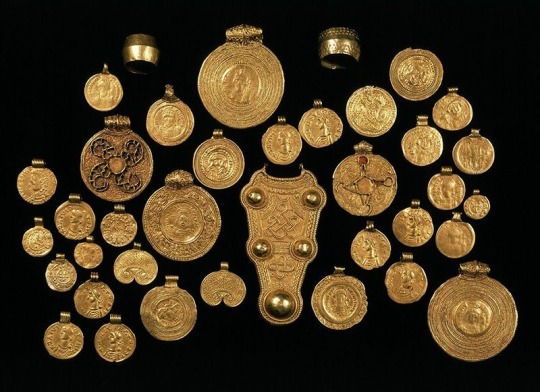
The Wiuwert/Wieuwerd treasure or hoard was found in a terp in modern Frisia.
The hoard was found in a little ceramic jar and contained the footplate of a bow brooch, two disc brooches with cloisonné, two “kidney brooches”, two finger rings, three bracteates and pendants.
These pendants were coins turned into jewelry. Their origin came from all over; Constantinopel, Ravenna, Viviers, Arles, Marseille, Sevilla and Maastricht. They are dated from the 6th and 7th century. It is assumed that the other jewelry was made from melted coins. The find itself is dated around 630.
No human remains are associated with the hoard. Most likely they belonged either to a gold smith or a local leader.
Rijksmuseum van Oudheden, Leiden - The Netherlands
Found in Wieuwerd, Frisia - The Netherlands
#frankish#merovingian#viking archaeology#archaeology#carolingian#charlemagne#field archaeology#viking mythology#merovingian archaeology#germanic mythology#norse mythology#anglo saxon#field archaeologist#frisian#viking#vikings#germanic#germanic folklore#germanic archaeology#odin#wodan#anglo saxon archaeology#history#jewelry#norse
308 notes
·
View notes
Text
Tattoos of the Near East and Europe
Knowing the full history of tattooing is practically impossible as skin doesn't usually leave a record of itself except in very special circumstances. Despite this, we do know that tattooing goes back quite a long time in human history and span almost every culture in the world. Joann Fletcher, a research fellow at the University of York in the United Kingdom, works with ancient Egyptian mummies, who were once thought to be the first group of people to tattoo because they mummified their dead. However, with the discovery of Ötzi the Iceman, that date was pushed back even farther because he was mummified by the cold, preserving his skin for 5300 years, about 1300 years before the earliest known Egyptian mummy to have one.

Tattoos on the body of Ötzi, the Tyrolean Iceman South Tyrol Museum of Archaeology / EURAC / Samadelli / Staschitz
Ötzi's tattoos lead us to believe that they were for health reasons, to alleviate the pain of strained or degenerating joints. His tattoos were not placed in such a way that would allow for easy display of status, given they were placed over his lower spine and right knee and ankle.

This blue bowl (circa 1300 B.C.E.), housed in the Rijksmuseum van Oudheden in Leiden, Amsterdam, features a musician tattooed with an image of the household deity Bes on her thigh. Joann Fletcher
Ancient Egyptians had figurines with tattoos as early as 4000 BCE and began representing them in tomb paintings around 1200 BCE and tools dated to around 1450 BCE were found near Gurob in northern Egypt. The vast majority of the people that were tattooed in these figurines and paintings, as well as mummies, were female and the tattoo was placed on their thighs, breasts, and abdomens. Because of the gender of the tattooed person and the archaeologists (largely male), for a long time, they were dismissed as 'dancing girls'. That the mummies were found in Deir el-Bahari, where the upper crust were berried, only managed to move the description to 'probably a royal concubine' (basically 'fancy' sex workers). However, Fletcher is of the opinion that these tattoos may have been a permanent amulet, probably tot aid in pregnancy and birth and possibly against sexually transmitted diseases. She also thinks that it was older women who would tattoo the younger women, perhaps as a way of passing down their own strength and fortitude to them.
This is in contrast to other cultures that used tattoos for decoration, though there is some evidence that there were therapeutic ones within the ones we've found preserved. Ancient Libyans were depicted by the Egyptians around 1300 BCE with male leaders wearing geometrical tattoos on their arms and legs.

Tattoo on the arm of a Pazyryk tribal chief, Altai Mountains, 5th century B.C.E. The Hermitage Museum
The Scythian Pazyryk of the Altai Mountain region of Siberia also used ornate tattoos all over their bodies, including mythical creatures on both a male and female ice people. These mummies date to about 400 BCE. The Greek historian Herodotus wrote about the Scythians and Thracians that their 'tattoos were a mark of nobility, and to not have them was testimony of low birth'. This stood out to him because the Greeks and Romans only really used tattoos to show that someone 'belonged' to either a religious sect or a person, or had been a criminal.

Greek vase (circa 450-440 B.CE.) depicting the death of Orpheus by a tattooed Thracian ArchaiOptix, CC BY-SA 4.0, via Wikimedia Commons
Despite these leanings, Ptolemy IV of Egypt (reigning from 221-205 BCE) was tattooed with ivy leaves to symbolize his devotion to Dionysus, who was the patron god of royalty as well as wine at the time. This led to Roman soldiers also getting tattoos, at least until Christianity spread; then they were found again to be disfiguring and banned by Emperor Constantine.
The trend of Christianity spreading at the end of a sword or gun caused a lot of native cultures tattooing practices to be vilified.
(TBC)
#tattoos#tattoo history#human history#mummies#Ötzi#otzi the iceman#egyptology#ancient egypt#ancient greece
7 notes
·
View notes
Text
45 notes
·
View notes
Text

Egypt bans Dutch archaeology team from Saqqara due to museum’s ‘Afrocentric’ exhibition
A team of archaeologists from a Dutch museum has been banned from carrying out excavations in Egypt’s rich Saqqara necropolis, after the museum mounted an exhibition that drew condemnation from Egyptian authorities.
After the opening of “Kemet: Egypt in Hip Hop, Jazz, Soul & Funk,” the National Museum of Antiquities (RMO) in Leiden received an email from the head of foreign missions of the Egyptian Antiquities Service saying that the museum is “falsifying history” with its “Afrocentric” approach, Dutch newspaper NRC reported on Monday.
Wim Weijland, the museum’s managing director, confirmed to CNN via email that the Egyptian authorities have denied the institution a permit for the next excavation season at Saqqara. He also confirmed that the journalist who wrote the NRC article had seen the email from the Egyptian authorities.
A vast burial ground that sits nearly 20 miles south of the capital Cairo, Saqqara is home to Egypt’s oldest pyramid, the pyramid of Djoser, and has been the site of multiple important discoveries in recent years.
The museum has been carrying out annual excavations there for more than 40 years. Its most recent excavation campaign took place earlier this year, between February 19 and March 23.
“The Rijksmuseum van Oudheden has been working at Saqqara since 1975,” Weijland told CNN. “For the upcoming season, the museum has been denied the permit to excavate here.”
Weijland said the reason for the permit’s denial is the “presumed ‘falsifying history’ in the current exhibition,” adding that the museum is trying to “open the dialogue” with the Egyptian authorities about the matter.
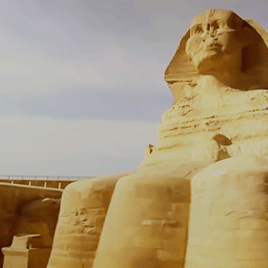
Mostafa Waziri, secretary-general of the Supreme Council of Antiquities of Egypt, did not respond to CNN’s request for comment.
Weijland went on to say that the aim of the “Kemet” exhibition is “to show and understand the depiction of ancient Egypt and the messages in music by African artists,” as well as to “show what scientific, Egyptological research can tell us about ancient Egypt and Nubia.”
Nubia is an ancient region in northeast Africa that extends from the Nile River valley in Egypt, all the way down to Khartoum in modern-day Sudan. The area was once home to the Nubian Kingdom of Kush, or the “African Pharaohs.”
According to its web page, the exhibition, which opened in April and runs until September 3, “embarks on a journey through music history” and looks at “the influence of ancient Egypt and Nubia…in the works of a multitude of musicians of African descent, including icons of jazz such as Miles Davis and Sun Ra and contemporary artists such as Beyoncé and Rihanna.”
In recent days, the museum’s social media posts about the exhibition were flooded with comments, mostly by Egyptians who deemed it disrespectful. Some commented with photos showing light-skinned ancient Egyptian drawings, next to ones with darker skin tones, which they say the museum is propagating.
In response to the controversy, the museum added a note on its website with further information about the show’s content, background and goals. It also said it would remove offensive or racist comments from its social media platforms.
The museum encouraged visitors to “visit the exhibition and form their own opinions,” saying it “welcomes respectful dialogue on the cultural heritage of Egypt and Nubia.”
This isn’t the first time Egypt has objected to the depiction of its ancient ancestors. It recently criticized the Netflix docuseries “Queen Cleopatra,” which portrays the ruler of the Ptolemaic Kingdom of Egypt as a woman of color.
Zahi Hawass, an Egyptologist and former Egyptian minister of antiquities, wrote last month that “no one with even a little education could make a film showing Cleopatra as African
#african#afrakan#kemetic dreams#africans#afrakans#brownskin#brown skin#african culture#afrakan spirituality#north ifriqiya#ifriqiya#cnn#cnn news#nubia#ta meri#ta seti#east africa
25 notes
·
View notes
Text
Merovechpark, Rijnsburg

Merovech was een Frankische koning die regeerde van 447 tot 458. Naar hem is de Merovingische dynastie vernoemd. In de periode na de Romeinse overheersing kwam het Frankische Rijk, het West-Europa van nu, tot bloei. Het park en de straatnamen in deze buurt zijn vernoemd naar het gevonden
Opgegraven schatten
Het grafveld in Rijnsburg, ligt binnen een oude meander van de Vliet ten zuiden van het Oegstgeesterkanaal. Het werd in 1913 ontdekt bij het dieper omspitten van een perceel tuinbouwgrond.

Een tuinder wilde zijn grond verbeteren en begon deze om te spitten. Tot zijn grote verrassing kwam hij op zijn perceel potten tegen met daarin resten van verbrande botten, kralenkettingen en andere sieraden.
Later zijn nog veel meer graven met schatten gevonden. In het grafveld werden tussen 550 en 675 mensen begraven. Een groot deel van de schatten is te zien in het Rijksmuseum van Oudheden in Leiden en in het Museum Oud Rijnsburg.
Het grafveld strekt zich uit over een afstand van ongeveer 100 bij 100 meter. Daarbinnen zijn zowel lijkgraven als crematies aangetroffen. Er zijn aanwijzingen voor in elk geval 255 graven, waarvan ongeveer 30% een lijkbegraving is. De mensen die in dit grafveld begraven zijn moeten geleefd tussen 550 en 700 n chr.
Graven met status
Niet iedereen werd zomaar op dit grafveld begraven. Vooral belangrijke personen kregen er een plaats. Volwassen vrouwen werden begraven met kleurrijke kralenkettingen. Mannen werden vaak begraven met een wapenuitrusting.
In een van de graven is een zwaardkraal gevonden. Dit is een geluksteen die aan een koord bij het zwaard hing. Een gouden gesp is de meest bijzondere vondst. Rijkversierde gespen en andere sieraden lieten zien dat je bij een belangrijke groep mensen hoorde.

De gevonden gesp is versierd met gouddraad en granaten (rode edelstenen). Uit onderzoek blijkt dat de granaten helemaal uit India kwamen! Waarschijnlijk was de drager van de gesp iemand die de koning vaak ontmoette. Doden werden volledig gekleed begraven, mannen met hun wapens, vrouwen met hun sieraden. In vaatwerk van glas en aardewerk kregen ze voedsel en drank mee.
Het kralenveld
Centraal in het park liggen kralen die doen denken aan de schatten die in de graven gevonden zijn. Het zijn uitvergrote kralen van keramiek. Het koord van de ketting is altijd verteerd als dit soort kralenkettingen wordt gevonden. De kralen liggen dan ook nogal rommelig. Maar als je goed kijkt, kun je wel de vorm van de kralenketting herkennen. Ook de zwaardkraal ligt ertussen. Deze is van natuursteen gemaakt. Het patroon van de gevonden gouden gesp is op een bank aangebracht. Vanaf die bank heb je een mooi zicht op het kralenveld.

Merovingen in Nederland
De Merovingische dynastie, oorspronkelijk afkomstig uit het tegenwoordige Nederland, heeft ook nadat het politieke zwaartepunt naar het zuiden verschoof in Nederland sporen achtergelaten. Dagobert I (625 – 639) probeerde zijn grondgebied verder uit te breiden naar het noorden, door de Friezen onder zijn gezag te brengen. Hij was geïnteresseerd in de handelsstad Dorestad, dat in de buurt van het huidige Wijk bij Duurstede lag.
Een ander motief om de Friezen te willen inlijven was religieus: de doop van de katholieke Clovis ontketende een tweede kerstening in Europa waar ook de Friezen doelwit in waren. De Merovingische strijd om het gebied viel samen met de komst van Bonifatius. De inname van Dorestad, het nabijgelegen Utrecht en het gebied van de Friezen ging evenals de kerstening niet zonder slag of stoot, voordat het in de 8e eeuw definitief bij het Frankische Rijk werd gevoegd.

De Friezen waar hier over gesproken wordt moet een verzameling zijn van nakomelingen van Cananefaten, Warnen, oorspronkelijke Friezen, Angelen en Saksen en reeds gevestigde Franken. Germanen die niet het volk van de Franken behoorden werden mogelijk Friezen genoemd. West Frisia, zoals het gebied genoemd wordt, had in de periode van de 7e. tot en met de 10e. eeuw ongeveer 7500 inwoners.
Bewijzen van bewoning zijn gevonden in Katwijk-Zanderij en Oegstgeest-Overdorp. Het gaat om fibula’s die dateren uit de late vijfde en zesde eeuw.
25-5-2024
1 note
·
View note
Text

Depiction of wadjet on an Egyptian papyrus: the Eye of Horus, ancient symbol of protection and good health. Rijksmuseum van Oudheden, Leiden.
0 notes
Text




Wat? Zelfportret ((1623-1630) door Peter Paul Rubens, Zelfportret met bloemenhoed (1883) door James Ensor, Christus en Johannes (ca. 1312) door Meester Heinrich von Konstanz en Koning en koningin (1952-1953) door Henry Moore
Waar? Tentoonstelling Zeldzaam en Onmisbaar – Topstukken uit Vlaamse collecties in MAS, Antwerpen
Wanneer? 7 januari 2024
Van Peter Paul Rubens zijn vier zelfportretten bewaard gebleven. Het portret op deze tentoonstelling stelt de schilder voor met een zwierige zwarte hoed. Ruim tweeënhalve eeuw later schildert James Ensor zichzelf, net als Rubens tegen een neutrale achtergrond. Vijf jaar later verandert hij een aantal elementen aan het werk. Zo voegt hij een fleurige bloemetjeshoed met pluim toe. Wie de werken van Rubens en Vermeer naast elkaar ziet, moet wel constateren dat Ensor het werk van zijn illustere voorganger als inspiratiebron gebruikte. Maar wat wil hij ermee zeggen? Parodieert hij zijn collega of zet hij zich zelfbewust neer als de Rubens van de negentiende eeuw?
Meester Heinrich von Konstanz vervaardigde in de veertiende eeuw het beeld Christus en Johannes. Toen zes eeuwen later beeldhouwer Henry Moore dit beeld zag, ontroerde dit hem sterk. Het vormde mede inspiratie voor het werk Koning en Koningin. De maker verklaarde dat het hoofd van de man ‘iets dierlijks en iets koninklijks’ heeft. Ook schijnt het werk mede-geïnspireerd te zijn op Egyptische faraobeelden. Daar kan ik me veel bij voorstellen. De gewaden en de positie van de voeten doen beslist denken aan beelden zoals dat van Nahotep en Nofret in het Egyptisch Museum in Caïro of Maya en Merit in het Rijksmuseum van Oudheden in Leiden.
0 notes
Text
Een stukje prehistorisch slaapbeen
In mijn enthousiasme zwiep ik de deur net iets te hard open. Klabats, zo tegen Harry aan. Als ik om de deur kijk, zie ik dat hij zijn hoofd verliest. Letterlijk. De plastic schedel van het educatieve skelet kletste op de grond in drie delen uiteen. Gelukkig precies de delen die opzettelijk demontabel waren gemaakt: de onderkaak, de schedelbasis en de schedelkap. Hij was dus nog te redden. Zorgvuldig zette ik de schedel weer in elkaar. Ongemerkt nam ik de anatomie in mij op.
Wie het kleine niet eert…
Toen ik net begon met verzamelen, nam ik iedere botsplinter mee naar huis. Alleen al het feit dat het fossiel was, was voldoende, daar was is hartstikke blij mee. Maar naarmate ik meer vond, werd ik kieskeuriger. Op een gegeven moment liep ik de splinters gewoon voorbij. Doodzonde want later kwam ik er achter dat sommige fragmenten buitengewoon interessant kunnen zijn. Bijvoorbeeld omdat ze bewerkt zijn, vraatsporen hebben of toch aanknopingspunten bevatten om ze te determineren.
Tegenwoordig bestudeer ik ieder fragment dat voor mijn voeten komt dus aandachtig daarna besluit ik of het mee naar huis gaat. De stelregel is: het moet bewerkt of ogenschijnlijk te determineren zijn.

Een botsplinter dat vanwege de vorm mee naar huis ging.
Dat iets te determineren is, wil niet zeggen dat dat ook lukt. Soms heeft een stuk een aantal kenmerkende elementen maar kom je er toch niet uit. Zelfs niet na ampel onderzoek. Wanneer me dat overkomt, belandt zo’n stuk in een daarvoor bestemde la: komt tijd, komt raad.
Een voortschrijdend inzicht
Zo eens in de zoveel tijd trek ik die la open in de hoop op een voortschrijdend inzicht. Vaak gaat de la vervolgens onverrichter zake weer dicht, maar soms gaat er ineens een lampje branden. Zo ook toen ik onlangs de la weer eens opende.
In de la lag een stuk dat ik herkende een stuk uit de schedelbasis van Harry. Als ik het goed had dan kwam het stuk overeen met een onderdeel van het slaapbeen het educatieve skelet. En dus met die van een menselijke schedel. En als dat zou kloppen dan was dit een fantastisch vondst!
De volgende dag nam ik het stuk mee naar mijn werk om het een op een te vergelijken.


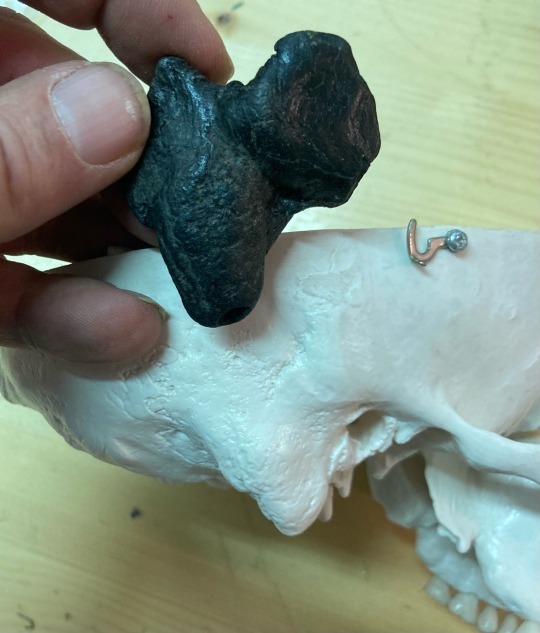
Vergelijkend onderzoek.
En wel wis en waarachtig! Het paste precies. Het door mij gevonden fossiel was een deel van het slaapbeen. Zonder twijfel het pars mastoidica oftewel het mastoid.
Mesolithisch
Gezien de zwarte kleur en de vindplaats, de Zandmotor, is het zeer aannemelijk dat het bot afkomstig is van een mesolithische jager-verzamelaar. Andere vondsten van de Zandmotor met een dergelijke kleur en conservering zijn namelijk als zodanig gedetermineerd. Het betreft de stoffelijke resten van mensen die in het in de Noordzee verdwenen Doggerland leefde.
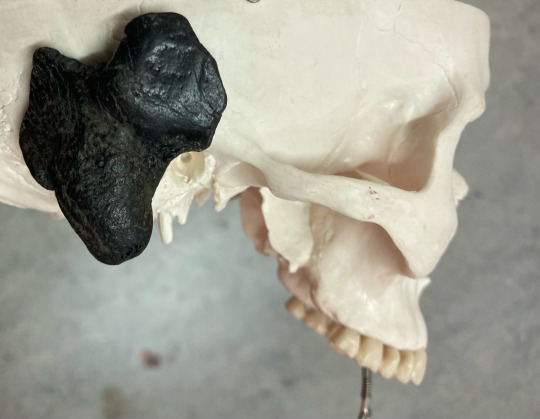
Het stuk mastoid in de oorspronkelijke positie.
Onderzoek
Op dit moment wordt er door Eveline Altena van het Leids Universitair Medisch Centrum en Luc Amkreutz van het Rijksmuseum van Oudheden en de Faculteit der Archeologie van de Universiteit Leiden in samenwerking met een DNA-lab in Leipzig onderzoek gedaan naar het DNA van deze bewoners van Doggerland. Daarom wordt uit de Noordzee verzameld menselijke materiaal gebruikt. Het doel is de genetische variatie van jagers-verzamelaars in kaart te brengen. Dit levert namelijk informatie op over bijvoorbeeld hoe groot die groepen mensen waren, of ze veel of weinig contact met elkaar hadden en hoe ze veranderden in de loop van de tijd.
Ik heb mijn vondst, alsmede een eerder gevonden kaakfragment, aangeboden voor dit onderzoek. Of het wordt meegenomen is echter de vraag. Ik heb er namelijk met mijn blote mannenklauwen aangezeten. En dat is voor het onderzoek niet gunstig. Eerdaags ga ik langs om de stukken te laten beoordelen. Daarna hoort u van mij.
6 notes
·
View notes
Text

Detail of Hornedjitef's canopic chest, with jackal gods (Duamutef?) bringing offerings to what I guess is a shrine of Osiris. I took this photo at the exhibition Discovering Ancient Egypt at the National Museum of Australia.
When: Ptolemaic Egypt
Where: Rijksmuseum van Oudheden, Leiden
45 notes
·
View notes
Text

“Kemet: Egypt in Hip Hop, Jazz, Soul & Funk” is a major summer exhibition @ the Dutch National Museum of Antiquities, The Rijksmuseum van Oudheden in Leiden
1 note
·
View note
Text

Silver diadem of Nubkheperre Intef
This silver diadem was thought to have come from Nubkheperre Intef’s Dra’ Abu el-Naga tomb. Nubkheperre Intef (also known as Antef, Inyotef, and Intef VI) was an Egyptian ruler of the 17th Dynasty of Egypt who reigned in Thebes during the Second Intermediate Period, when Egypt was divided into rival dynasties, including the Hyksos in Lower Egypt.
Further examination indicated that the royal owner of the diadem could no longer be identified. It has sparked some conjecture, thanks in part to the mysterious circumstances surrounding its discovery. A second potential 17th dynasty royal headwear piece has been identified by British Egyptologists, which may have originated with the burial of Queen Mentuhotep, King Djehuti’s wife.
The diadem’s band is 55.5 cm in circumference and is made of 1 to 1.5 millimetre thick hammered silver leaf. Both ends are soldered together. Line patterns have been applied at regular intervals to make a block frieze. The long hanging ribbons are made up of two strips of silver leaves.
Pieces of linen were discovered inside the ribbons. These must be from the wrappings around the mummy’s head, where the jewellery was recovered. The uraeus is constructed of 16 to 18-carat gold. Faïence inlays are formed into the shape of a lotus blossom.
Second Intermediate Period, 17th Dynasty, c. 1647 B.C. Now in the Rijksmuseum van Oudheden, Leiden. AO 11a-2
Read more
66 notes
·
View notes
Text
Belt Fitting/ belt mount
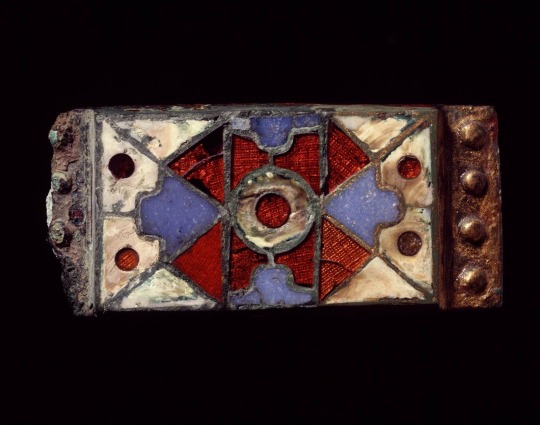
Merovingian dynasty Europeans loved to wear belts. They were today’s purses and held plenty of people’s personal belongings and hygiene tools. It’s possible that a variety of materials were used as belts, such as simple ropes from natural material, tablet woven belts, but most known are leather belts.
The leather has decayed, but it’s decorations show the owner’s wealth. Leather belts were decorated with metal mounts, in the case of belts more often called “fittings”. These fittings include thick pins on the back which allows for a secure fit.
Most often a belt consisted of a metal buckle, with the other end being decorated with another, often matching in style fitting. These often have different shaped, which may indicate that the edges of the leather were shaped to taste. The most elaborate belts consist of fittings all over the length of the belt.
The example above is a rarer decoration style, with enamel used instead of a full metal relief decorated or garnet decorated fitting. Despite being found in a grave dated to 630-640, the style may indicate that the fitting is actually older, most likely being passed on from one generation to the next, possibly originating from the 500-550’s.
Rijksmuseum van Oudheden, Leiden, Zuid Holland - The Netherlands
Museum nr. h.1913/11.89
Found in Rijnsburg-Katwijk, Zuid Holland - The Netherlands
#frankish#merovingian#viking archaeology#archaeology#carolingian#charlemagne#field archaeology#viking mythology#merovingian archaeology#germanic mythology#norse mythology#anglo saxon#viking#field archaeologist#frisian#odin#vikings#germanic#germanic folklore#germanic archaeology#dress history
124 notes
·
View notes
Text
Gold und Silber
#Niederlande: Gold- und Silberschatz in Twente wird heute in #Enschede präsentiert.
Bereits vor knapp drei Jahren, nämlich im Mai 2019 fanden Hobbyarchäologen mit ihrem Metalldetektor im Naturschutzgebiet Springendal bei Hezingen in der niederländischen Gemeinde Tubbergen (Twente) eine Ansammlung von Gold- und Silbermünzen sowie Schmuck aus dem frühen Mittelalter. Die beachtliche Menge ließ sofort vermuten, dass es sich um einen (teilweise) gepflügten Gold- und Silberschatz…

View On WordPress
#Archäologie#Enschede#Jan Willem de Kort#Leiden#PAN#Portable Antiquities of the Netherlands#Rijksmuseum Twente#Rijksmuseum Twenthe#Rijksmuseum van Oudheden#Sachsen#Springendal#Stijn Heeren#Tubbergen#Twente#Vrije Universiteit Amsterdam
0 notes